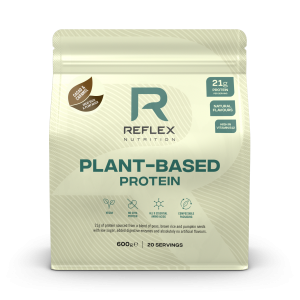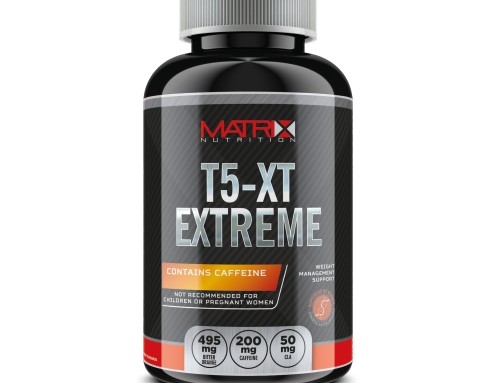Reflex Nutrition Plant Based Protein
Plant Based Protein is a supplement produced by UK based brand, Reflex Nutrition. This supplement is said to help with muscle gain. This review will assess the ingredients listed within this supplement to identify whether these claims can be backed up.
Ingredients
Plant Protein Blend (88%) (Pea Protein Isolate, Brown Rice Protein, Organic Pumpkin Protein),
Pea Protein has been shown to have the same effect on muscle mass as whey protein (1). It also contains a healthy amount of iron with a low amount of carbs,fat and sugar; which could be of benefit for people wanting to better control their blood glucose levels, (12).
Derived from yellow split peas the methods of extraction can vary ranging from salt extraction, micellization as well as alkaline extraction among many others, (13). One study found that the protein content of pea protein was higher than soy (14). Despite the positive benefits of Pea protein it has been found to be low in methionine which may need to be supplemented due to liver damage if insufficient,(15).
Rice Protein is extracted from rice flour and has been found to help mostly for post exercise recovery, (16). It does contain lysine, (an amino acid essential for muscle growth), however due to the lower quantity it the effects may occur in the longer term.
No matter what type of protein, all varieties help aid muscle protein synthesis when combined with resistance training (7, 8). Other key features include increasing muscle mass (3), an increase in lean body mass (9) and greater recovery from exercise (10). Longer periods of supplementation have shown greater gains in fat free mass (11).
[Cacao & Caramel flavour only: Cocoa Powder (5%)],
Cocoa powder has been found to include flavonoids which are antioxidants, they can aid in the oxidation of LDL, (13,14) and augments the antioxidant defence system (15). Cocoa powder has also been found to stimulate nitric oxide production which can reduce oxidative stress and reduce the risk of heart attack (16).
Sea Salt
Sodium chloride is otherwise known as salt. It is theorised that sodium chloride can help prevent cramps as the key mechanism in muscle contraction is the flooding of the action potential in the muscle membrane, and so if there is a sodium deficiency it may cause the muscle to cramp (17).
Thickener (Cellulose Gum)
Cellulose is used as a viscosity modifier or thickener, and to stabilize emulsions in various supplements and other products. It is known for its excellent water retaining capacity.
[Wild Berry flavour only: Colours (Betanin, Anthocyanins)],
Flavourings. No nutritional benefit
Sweetener (Sucralose)
Sucralose is a sweetener that is calorie free. This ingredient is used in many products and is used to make the product taste sweeter and does not have any nutritional benefit.
Bacillus coagulans (LactoSpore®)
Bacillus Coagulans is a probiotic meaning that it is a form of good bacteria, Its’ features include heat stability and the ability to survive in the stomach (18). There are several functions of this ingredient including immune stimulation(19, 20) and antimicrobial stimulation (21). In a randomised, double blind, placebo controlled study it was found that it had significant effects for people with rheumatoid arthritis (22), however more research is needed to fully establish this (23).
Multi-Component Protected Lactic Acid Bacteria (Bifidobacterium bifidum, Lactobacillus acidophilus, Lactobacillus rhamnosus)
Lactic acid bacteria is a probiotic. The health benefits of this ingredient includes regulating bowel movement which prevents diarrhea, lowering cholesterol and gives a boost to the immune system (24).
Vitamin B12 (Methylcobalamin).
Methylcobalamin is a form of Vitamin B12. Research studies on vitamin B12 have found that it is required for red blood cell production (25), protein synthesis and the repair and maintenance of tissue cells (26).
Summary
Plant Based Protein can be used by people who want to gain muscle but who don’t want to consume animal products. This supplement is best taken pre/post-workout. This product has no banned substances in reference to the WADA prohibited list when observing the label / ingredients posted on the website..
*NOTE – This product has not been tested in a laboratory and may contain other substances that may not appear on the label
References
1 – Babault, N., Païzis, C., Deley, G., Guérin-Deremaux, L., Saniez, M. H., Lefranc-Millot, C., & Allaert, F. A. (2015). Pea proteins oral supplementation promotes muscle thickness gains during resistance training: a double-blind, randomized, Placebo-controlled clinical trial vs. Whey protein. Journal of the International Society of Sports Nutrition, 12(1), 1-9.
2 – Mollard, R. C., Luhovyy, B. L., Smith, C., & Anderson, G. H. (2014). Acute effects of pea protein and hull fibre alone and combined on blood glucose, appetite, and food intake in healthy young men–a randomized crossover trial. Applied Physiology, Nutrition, and Metabolism, 39(12), 1360-1365.
3 – Lam, A. C. Y., Can Karaca, A., Tyler, R. T., & Nickerson, M. T. (2018). Pea protein isolates: Structure, extraction, and functionality. Food Reviews International, 34(2), 126-147.
4 – Gorissen, S. H., Crombag, J. J., Senden, J. M., Waterval, W. H., Bierau, J., Verdijk, L. B., & van Loon, L. J. (2018). Protein content and amino acid composition of commercially available plant-based protein isolates. Amino acids, 50(12), 1685-1695.
5 – Séité, S., Mourier, A., Camougrand, N., Salin, B., Figueiredo-Silva, A. C., Fontagné-Dicharry, S., … & Seiliez, I. (2018). Dietary methionine deficiency affects oxidative status, mitochondrial integrity and mitophagy in the liver of rainbow trout (Oncorhynchus mykiss). Scientific reports, 8(1), 1-14.
6 – Joy, J. M., Lowery, R. P., Wilson, J. M., Purpura, M., De Souza, E. O., Wilson, S. M., … & Jäger, R. (2013). The effects of 8 weeks of whey or rice protein supplementation on body composition and exercise performance. Nutrition journal, 12(1), 1-7.
7 – Coker, R. H., Miller, S., Schutzler, S., Deutz, N., & Wolfe, R. R. (2012). Whey protein and essential amino acids promote the reduction of adipose tissue and increased muscle protein synthesis during caloric restriction-induced weight loss in elderly, obese individuals. Nutr J, 11(1), 105.
8 – Hulmi, J. J., Lockwood, C. M., & Stout, J. R. (2010). Review Effect of protein/essential amino acids and resistance training on skeletal muscle hypertrophy: A case for whey protein.
9 – Pasiakos, S. M., McLellan, T. M., & Lieberman, H. R. (2015). The effects of protein supplements on muscle mass, strength, and aerobic and anaerobic power in healthy adults: a systematic review. Sports Medicine, 45(1), 111-131.
10 – Volek, J. S., Volk, B. M., Gómez, A. L., Kunces, L. J., Kupchak, B. R., Freidenreich, D. J., … & Kraemer, W. J. (2013). Whey protein supplementation during resistance training augments lean body mass. Journal of the American College of Nutrition, 32(2), 122-135.
11 – Hansen, M., Bangsbo, J., Jensen, J., Bibby, B. M., & Madsen, K. (2014). Effect of Whey Protein Hydrolysate on Performance and Recovery of Top-Class Orienteering Runners. International journal of sport nutrition and exercise metabolism.
12 – Hartman, J. W., Tang, J. E., Wilkinson, S. B., Tarnopolsky, M. A., Lawrence, R. L., Fullerton, A. V., & Phillips, S. M. (2007). Consumption of fat-free fluid milk after resistance exercise promotes greater lean mass accretion than does consumption of soy or carbohydrate in young, novice, male weightlifters. The American journal of clinical nutrition, 86(2), 373-381.
13 – Bearden MM, Pearson DA, Rein D, et al. Potential cardiovascular health benefits of procyanidins present in chocolate and cocoa. In: Parliment TH, Ho C-T, Schieberle P, eds. Caffeinated beverages: health benefits, physiological effects, and chemistry. Washington, DC: American Chemical Society, 2000:177–186
14 – Pearson DA, Schmitz HH, Lazarus SA, Keen CL. Inhibition of in vitro low-density lipoprotein oxidation by oligomeric procyanidins present in chocolate and cocoas. In: Packer L, ed. Methods in enzymology. Vol. 335. New York: Academic Press, 2001:350–60.
15 – Keen, C. L., Holt, R. R., Oteiza, P. I., Fraga, C. G., & Schmitz, H. H. (2005). Cocoa antioxidants and cardiovascular health. The American journal of clinical nutrition, 81(1), 298S-303S.
16 – Osakabe N, Sanbongi C, Yamagishi M, Takizawa T, Osawa T. Effects of polyphenol substances derived from Theobroma cacao on gastric mucosal lesion induced by ethanol. Biosci Biotechnol Biochem 1998;62:1535–8.
17 – McCance, R. A. (1936). Experimental sodium chloride deficiency in man.Proceedings of the Royal Society of London. Series B, Biological Sciences,119(814), 245-268.
18 – Cutting, S. M. (2011). Bacillus probiotics. Food Microbiology, 28(2), 214-220.
19 – Green, D. H., Wakeley, P. R., Page, A., Barnes, A., Baccigalupi, L., Ricca, E., & Cutting, S. M. (1999). Characterization of Two Bacillus Probiotics. Applied and environmental microbiology, 65(9), 4288-4291.
20 – Senesi, S., Celandroni, F., Tavanti, A., & Ghelardi, E. (2001). Molecular Characterization and Identification of Bacillus clausii Strains Marketed for Use in Oral Bacteriotherapy. Applied and environmental microbiology, 67(2), 834-839.
21 – Hong, H. A., Huang, J. M., Khaneja, R., Hiep, L. V., Urdaci, M. C., & Cutting, S. M. (2008). The safety of Bacillus subtilis and Bacillus indicus as food probiotics. Journal of applied microbiology, 105(2), 510-520.
22 – Mandel, D. R., Eichas, K., & Holmes, J. (2010). Bacillus coagulans: a viable adjunct therapy for relieving symptoms of rheumatoid arthritis according to a randomized, controlled trial. BMC complementary and alternative medicine,10(1), 1.
23 – Drago, L. O. R. E. N. Z. O., & De Vecchi, E. (2009). Should Lactobacillus sporogenes and Bacillus coagulans have a future?. Journal of chemotherapy,21(4), 371-377.
24 – Masood, M. I., Qadir, M. I., Shirazi, J. H., & Khan, I. U. (2011). Beneficial effects of lactic acid bacteria on human beings. Critical reviews in microbiology,37(1), 91-98.
25 – d’Onofrio, G., Chirillo, R., Zini, G., Caenaro, G., Tommasi, M., & Micciulli, G. (1995). Simultaneous measurement of reticulocyte and red blood cell indices in healthy subjects and patients with microcytic and macrocytic anemia. Blood,85(3), 818-823.
26 – Fenech, M. (2001). The role of folic acid and vitamin B12 in genomic stability of human cells. Mutation Research/Fundamental and Molecular Mechanisms of Mutagenesis, 475(1), 57-67.

| Use for | Muscle Gain |
| Website | Reflexnutrition.com |
| Price | £1.85 – 26.00 |




